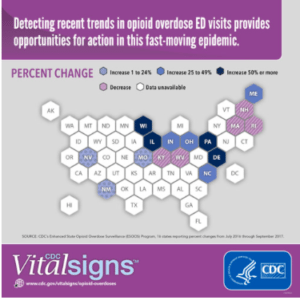New Report Shows 30 Percent Average Increase In ER Visits Because Of Opioid Overdoses
According to U.S. News and World Report, a review of data from emergency room departments (ED) across the U.S. between July 2016 and September 2017 by the Centers for Disease Control and Prevention (CDC) showed on average a 30 percent increase in people seeking treatment for opioid-related overdoses. The data was provided by EDs in 52 jurisdictions in 45 states and is considered essential in providing timely insights to the CDC into state and regional trends while death certificates are still in process. The most recent Vital Signs report is be viewed here.
In a press release issued with this new data, CDC Acting Director Anne Schuchat, M.D. said, “This fast-moving epidemic affects both men and women, and people of every age. It does not respect state or county lines and is still increasing in every region in the United States.” Also analyzed in this report was data from 16 states in the CDC’s Enhanced State Opioid Overdose Surveillance (ESOOS) Program which showed an average increase for opioid-related ED visits of 35 percent.
As reported by Newsweek, CDC’s report showed the most significant average increase - 70 percent - in opioid-related overdose ED visits in the Midwest region. The CDC defines the Midwest region as North Dakota, South Dakota, Nebraska, Kansas, Minnesota, Iowa, Missouri, Wisconsin, Illinois, Michigan, Indiana, and Ohio. Wisconsin’s figures saw the greatest increase with 109 percent while Missouri’s figures only increased by 21 percent. A February report from the Midwest Economic Policy Institute illuminated both the economic and personal cost that the opioid epidemic had on just the construction industry in 2015: 1,000 Midwest construction workers were killed because of opioids, and the local economy lost $5 billion.
No one thing is the cause of the opioid epidemic. The Drug Enforcement Administration stated in the 2017 National Drug Threat Assessment that “Illicit fentanyl and other synthetic opioids—primarily sourced from China and Mexico and shipped directly to the United States or trafficked overland via Mexico and Canada—are contributing factors in the current synthetic opioid overdose epidemic. Traffickers in the United States usually mix fentanyl into heroin products and sometimes other illicit drugs, or press it into counterfeit prescription pills, often without users’ awareness, which leads to overdose incidents.”
